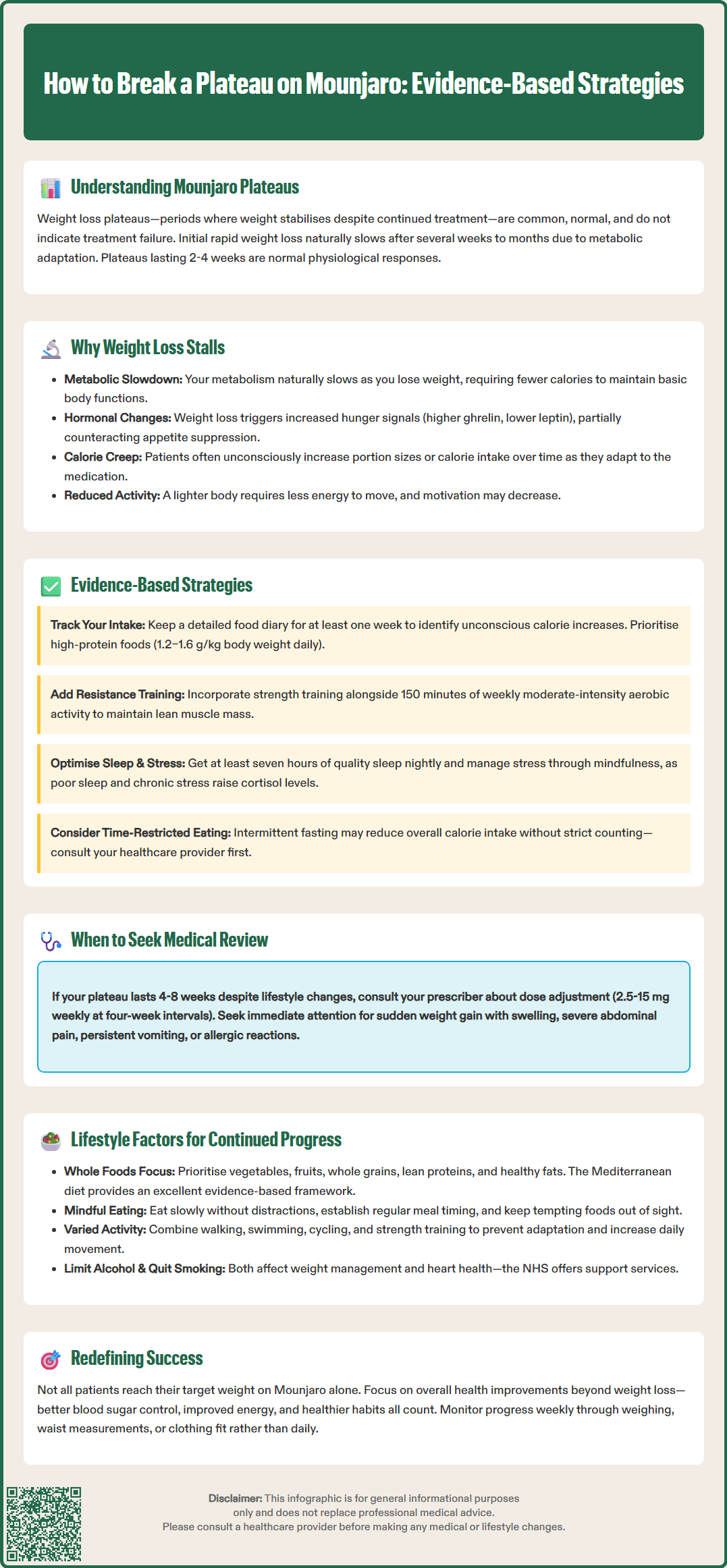
How to break a plateau on Mounjaro is a common concern for patients experiencing a temporary halt in weight reduction during tirzepatide therapy. Mounjaro (tirzepatide) is a dual GIP and GLP-1 receptor agonist licensed in the UK for treating type 2 diabetes mellitus in adults. Whilst clinical trials demonstrate substantial weight loss, plateaus—periods where weight remains stable despite continued treatment—are normal physiological responses, not treatment failures. Understanding why plateaus occur and implementing evidence-based strategies including dietary optimisation, increased physical activity, adequate sleep, and appropriate medical review can help patients overcome these temporary stalls and continue progressing towards their health goals.
Quick Answer: Breaking a plateau on Mounjaro involves systematic dietary review, increased physical activity (particularly resistance training), adequate sleep and stress management, and medical review for potential dose adjustment after 4-8 weeks of sustained weight stability.
Mounjaro (tirzepatide) is a dual glucose-dependent insulinotropic polypeptide (GIP) and glucagon-like peptide-1 (GLP-1) receptor agonist licensed in the UK specifically for the treatment of type 2 diabetes mellitus in adults. It is important to note that in the UK, tirzepatide for weight management is available under a separate licence and brand name (Zepbound), not Mounjaro.
Clinical trials have demonstrated substantial weight reduction in many patients taking tirzepatide, yet experiencing a weight loss plateau—a period where weight remains stable despite continued treatment—is a common and often frustrating occurrence.
A plateau does not indicate treatment failure. Weight loss is rarely linear; the body undergoes complex metabolic adaptations as it adjusts to reduced caloric intake and altered hormonal signalling. During the initial months of Mounjaro therapy, patients typically experience rapid weight reduction due to decreased appetite, delayed gastric emptying, and improved glycaemic control. However, after several weeks or months, the rate of weight loss naturally slows or temporarily halts.
Understanding that plateaus are a normal physiological response is essential for maintaining realistic expectations and treatment adherence. Research indicates that weight loss trajectories vary considerably between individuals, influenced by baseline metabolic rate, body composition, genetic factors, and concurrent lifestyle modifications. Patients should be reassured that short periods of weight stability lasting 2-4 weeks can be normal, provided other health parameters remain stable and the medication is well tolerated. Recognising this pattern helps prevent premature discontinuation of an otherwise effective therapy.
It is important to note that tirzepatide is not recommended during pregnancy or breastfeeding, and effective contraception should be used during treatment.

Mounjaro® is the most innovative GLP-1 medication proven to dramatically curb appetite, hunger, and cravings to help professional men achieve substantial weight loss.
Start Here
Wegovy® is a weekly injectable GLP-1 medication with proven effectiveness in reducing appetite, hunger, and cravings to help busy professionals lose significant weight.
Start HereSeveral interconnected physiological and behavioural factors contribute to weight loss plateaus during Mounjaro treatment. Metabolic adaptation, often termed adaptive thermogenesis, is a primary mechanism. As body weight decreases, the body's basal metabolic rate (BMR) declines proportionally, meaning fewer calories are required to maintain basic physiological functions. This adaptive response evolved as a survival mechanism but can impede further weight reduction.
Hormonal changes also play a significant role. Weight loss triggers alterations in appetite-regulating hormones including leptin, ghrelin, and peptide YY. Leptin levels decrease with fat mass reduction, potentially increasing hunger signals, whilst ghrelin (the 'hunger hormone') may rise, counteracting the appetite-suppressing effects of tirzepatide. Although Mounjaro's dual GIP/GLP-1 mechanism provides robust appetite control, these compensatory hormonal shifts can partially offset its effects over time.
Dietary habituation represents another common factor. Patients may unconsciously increase portion sizes or caloric density of meals as they become accustomed to the medication's effects. Additionally, reduced physical activity due to lower body weight (requiring less energy for movement) or decreased motivation can contribute to energy balance stabilisation. Fluid retention, particularly in women during certain phases of the menstrual cycle, may temporarily mask ongoing fat loss on the scales.
Finally, changes in medication response may be considered. While there is no established evidence that patients develop pharmacological resistance to tirzepatide, some attenuation of gastric emptying effects has been observed with incretin therapies over time. More commonly, the body reaches a new equilibrium where energy intake matches expenditure at the current dose, necessitating reassessment of the overall treatment strategy.

Breaking through a weight loss plateau requires a systematic, evidence-based approach that addresses both physiological and behavioural factors. Dietary review and optimisation should be the first consideration. Patients are advised to maintain a detailed food diary for at least one week to identify potential areas of caloric creep—the gradual increase in energy intake that often occurs unconsciously. Focus should remain on nutrient-dense, high-protein foods (1.2–1.6 g/kg body weight daily) which enhance satiety and preserve lean muscle mass during weight loss. Those with kidney disease or other medical conditions should consult their healthcare provider or dietitian before increasing protein intake.
Increasing physical activity, particularly resistance training, can help counteract metabolic adaptation. The UK Chief Medical Officers' guidelines recommend at least 150 minutes of moderate-intensity aerobic activity weekly, supplemented with muscle-strengthening exercises on two or more days. Resistance training is particularly valuable as it maintains or increases lean body mass, thereby supporting metabolic rate. Even modest increases in daily movement—such as additional walking or standing time—can contribute to breaking a plateau.
Intermittent fasting or time-restricted eating patterns may provide benefit for some patients, though evidence specific to Mounjaro users remains limited. These approaches can help reduce overall caloric intake without requiring meticulous calorie counting. However, patients should discuss such strategies with their healthcare provider to ensure compatibility with their diabetes management plan, particularly if taking insulin or sulfonylureas, due to hypoglycaemia risk.
Adequate sleep and stress management are often overlooked but evidence-based components of weight management. Poor sleep quality (less than seven hours nightly) and chronic psychological stress elevate cortisol levels, which can promote central adiposity and insulin resistance. Addressing these factors through sleep hygiene practices and stress-reduction techniques such as mindfulness or cognitive behavioural approaches may support renewed weight loss. Patients should avoid drastic caloric restriction, which can further suppress metabolic rate and prove counterproductive.
Dose adjustment may be appropriate for patients experiencing a sustained plateau, but must always be directed by the prescriber in accordance with the Summary of Product Characteristics (SmPC). Mounjaro is available in the UK in doses ranging from 2.5 mg to 15 mg administered once weekly via subcutaneous injection. The prescribing information recommends gradual dose increases at four-week intervals to optimise tolerability whilst enhancing glycaemic control and weight reduction.
Patients should request a medical review if their weight has remained stable for 4-8 weeks or longer despite adherence to lifestyle modifications and medication. During this consultation, the healthcare provider will assess several factors: treatment adherence, injection technique, concurrent medications that may affect weight (such as certain antidepressants, antipsychotics, or corticosteroids), and underlying medical conditions including hypothyroidism or polycystic ovary syndrome that could impede weight loss.
Situations requiring prompt medical attention include: sudden unexplained weight gain with ankle swelling or breathlessness (suggesting fluid retention); severe abdominal pain, especially radiating to the back (possible pancreatitis); right upper abdominal pain, fever or yellowing of the skin/eyes (potential gallbladder disease); persistent vomiting or poor oral intake (risk of dehydration); and any signs of allergic reaction. Patients with type 2 diabetes should also contact their GP if experiencing recurrent hypoglycaemia, as this may indicate the need for adjustment of concurrent glucose-lowering medications.
It is important to note that tirzepatide can reduce exposure to oral contraceptives. Women using oral contraceptives should consider additional barrier or non-oral contraception for 4 weeks after starting treatment and after each dose increase.
Not all patients will achieve their target weight on Mounjaro alone. NICE guidance suggests that combination approaches, including referral to specialist weight management services or consideration of bariatric surgery for those meeting eligibility criteria (BMI ≥40 kg/m² or ≥35 kg/m² with comorbidities), may be appropriate. Healthcare professionals should discuss realistic expectations and individualised treatment goals, focusing on health improvements beyond the number on the scales, such as improved glycaemic control, blood pressure reduction, and enhanced quality of life.
Patients should report any suspected side effects to their healthcare professional or directly to the MHRA Yellow Card Scheme.
Sustainable weight management on Mounjaro requires integration of evidence-based lifestyle modifications that complement the medication's pharmacological effects. Dietary quality matters as much as quantity. Patients should prioritise whole foods including vegetables, fruits, whole grains, lean proteins, and healthy fats whilst minimising ultra-processed foods high in added sugars and refined carbohydrates. The Mediterranean dietary pattern, endorsed by numerous cardiovascular and metabolic health guidelines, provides an excellent framework. Adequate hydration (6-8 glasses of fluid daily for most adults, as recommended by the NHS) supports metabolic processes and can help distinguish true hunger from thirst.
Behavioural strategies form the cornerstone of long-term success. These include:
Mindful eating practices: eating slowly, without distractions, and stopping when comfortably satisfied rather than overly full
Regular meal timing: establishing consistent eating patterns to regulate appetite hormones
Environmental modification: keeping tempting foods out of immediate sight and stocking the home with nutritious options
Social support: engaging family members or joining support groups to maintain motivation and accountability
Physical activity diversification can prevent adaptation and maintain engagement. Combining different exercise modalities—such as walking, swimming, cycling, and strength training—challenges the body in varied ways and reduces injury risk from repetitive strain. Patients should aim to increase non-exercise activity thermogenesis (NEAT) through simple modifications like taking stairs, parking further away, or using a standing desk.
Alcohol moderation and smoking cessation are important additional considerations. Both alcohol consumption and smoking affect weight management and cardiometabolic risk. The NHS offers support services for those wishing to reduce alcohol intake or quit smoking.
Regular self-monitoring without obsession is beneficial. Weekly weighing at the same time of day, preferably in the morning after voiding, provides useful feedback whilst avoiding the anxiety associated with daily fluctuations. Some patients may prefer monitoring waist circumference or how clothing fits as alternative progress indicators. Psychological wellbeing must not be neglected; patients experiencing emotional eating patterns, body image concerns, or symptoms of depression or anxiety should be offered appropriate support, which may include referral to NHS Talking Therapies or other psychological services. Weight management is a marathon, not a sprint, and maintaining a compassionate, patient-centred approach optimises long-term outcomes on Mounjaro therapy.
Short periods of weight stability lasting 2-4 weeks are considered normal during Mounjaro treatment. If your plateau extends beyond 4-8 weeks despite adherence to lifestyle modifications, you should request a medical review to discuss potential dose adjustment or other contributing factors.
No, dose adjustments must always be directed by your prescriber in accordance with the Summary of Product Characteristics. Mounjaro doses range from 2.5 mg to 15 mg weekly, with gradual increases recommended at four-week intervals to optimise tolerability and effectiveness.
Maintaining a detailed food diary to identify caloric creep, prioritising high-protein foods (1.2-1.6 g/kg body weight daily), focusing on nutrient-dense whole foods, and ensuring adequate hydration (6-8 glasses daily) can help break through weight loss plateaus. Patients with kidney disease should consult their healthcare provider before increasing protein intake.
All medical content on this blog is created based on reputable, evidence-based sources and reviewed regularly for accuracy and relevance. While we strive to keep content up to date with the latest research and clinical guidelines, it is intended for general informational purposes only.
DisclaimerThis content is not a substitute for professional medical advice, diagnosis, or treatment. Always consult a qualified healthcare professional with any medical questions or concerns. Use of the information is at your own risk, and we are not responsible for any consequences resulting from its use.